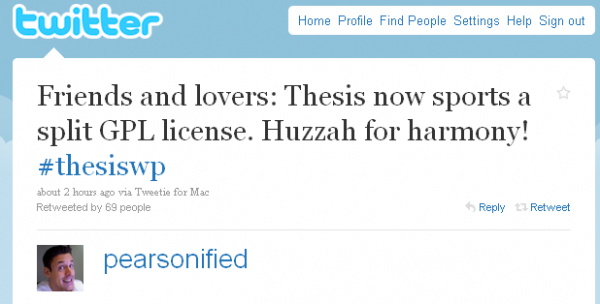Crisis Averted: Thesis Submits To WordPress GPL
After a heated debate between the founder of WordPress (Matt Mullenweg) and the creator of the mighty Thesis theme (Chris Pearson), it looks like cooler minds have prevailed with Pearson finally embracing GPL for Thesis via a split license.
Friends and lovers: Thesis now sports a split GPL license. Huzzah for harmony!#thesiswp (via @Pearson) […]
@tomoswyn It has no practical implications for 99.9% of people. It just means the PHP is GPLv2 and the CSS, JS, and images are proprietary. (via @Pearson)
Previously Mullenweg hinted at taking Pearson to court over the GPL violation, which resulted in many bloggers debating over whether or not GPL could be enforced upon a theme developers (at least within the US).
Mullenweg (who admittedly is a huge fan of GPL himself) was not thrilled with Thesis’s GPL rebellion and offered Thesis fans a way to acquire a premium theme of their choice free of charge.
As I said on Twitter, if there’s another premium theme you’d like to try out I’m happy to buy you a copy, just send a link and your info to my contact form. It’s better to choose a solid platform now rather than put it off until later. (Matt Mullenweg)
With Thesis selling for $87 and $164 for individual and developer licenses, respectively, it looks as if Pearson’s GPL adoption has saved Mullenweg hundreds of dollars (although truth be told his generous offer is a lot less expensive than hiring a team of lawyers).
Pearson’s embrace of GPL will probably be followed by other WordPress theme developers, many who avoided embracing GPL out of fear of giving up legal rights over their creations.
Now that the legal dust has settled and the lawyers have been called off, Automattic can refocus its efforts into improving WordPress products (like VaultPress as well as bbPress) and Chris can focus on creating superior WordPress themes without being attacked by members in the community.
(via Mashable)
Darnell Clayton is a geek who discovered blogging long before he heard of the word "blog" (he called them "web journals" then). When he is not tweeting, friendfeeding, or blogging about space, he enjoys running, reading and describing himself in third person.



That’s a satisfying ending, I think. It was getting a bit too heated in the Twitterverse, with outsiders making the harshest statements.
Can’t we all get along? I think we can. Or else.
I agree Daniel. Truth be told I’m not fond of GPL myself (I prefer Apache 2.0 license), although I have yet to find a better platform (software wise) than WordPress so I respect the license.
This will also probably help bring the community closer together, although I wonder if Matt will embrace Thesis now that it’s compliant?
Darnell I don’t think this will bring the community closer together. This whole mess has opened up a whole can of worms with a nasty behavior that can be unleashed with a flick of a twitter message.
So they will have been coerced to follow the party line or else face nasty public tweets, threats etc. This all because some vocal leadership which presents zero case for their view says so except for a biased SFLC piece?
Hurray for the community, this benefits us greatly (sic).
I’m not an expert on GPL but can someone explain this:
http://bundlethemes.com/woothemes-bundle
@Keith
Its perfectly ok with the GPL. You can give away as a bonus for your email newsletter and what not.
I felt sorry for Chris; basically because I thought think Matt was wrong. Though I heard it became knowledge AFTER the ‘discussions’ that Chris had violated the use of WordPress code. A good a reson as any for backing downm, I guess.
On the other hand, I think it should be up to a developer whether he wants to use GPL for his WordPress themes or plug-ins. AFAICS if he hasn’t used any WordPress code and doesn’t distribute his code with WordPress then he is not violating any license.
Of course, not making it GPL means that developers cannot distribute it with WordPress without violating the GPL license. But that’s a separate issue.
Personally I think that Matt’s efforts would be better put to use tackling absolutely blatant violations, such as this one I saw from someone selling web-sites on the warrior forum: I have a developer’s license for Autoblogged plugin and am now including a copy for single personal use for each web package purchased.
So much for the whole being under GPL.